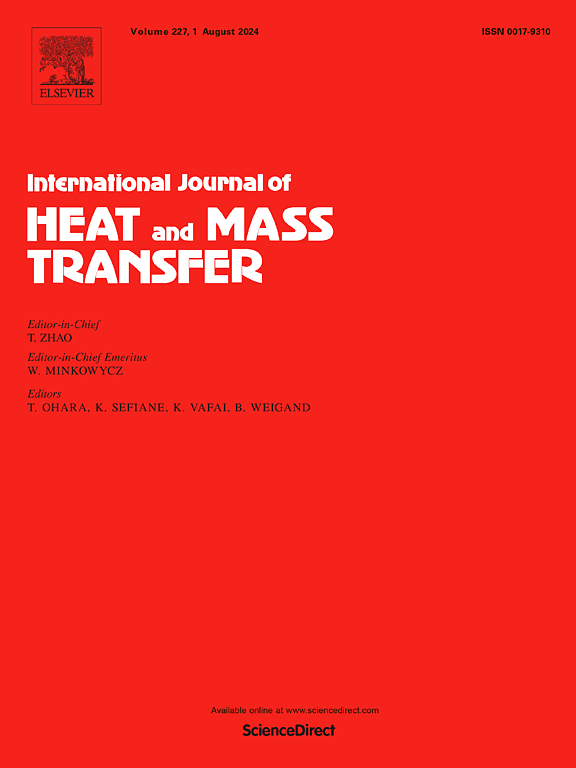利用红外热成像技术高时空分辨率测量水平方形微型通道中的水流沸腾传热
IF 5
2区 工程技术
Q1 ENGINEERING, MECHANICAL
International Journal of Heat and Mass Transfer
Pub Date : 2024-11-25
DOI:10.1016/j.ijheatmasstransfer.2024.126457
引用次数: 0
摘要
本研究使用高时空分辨率(4000 fps,0.025 mm/像素)的红外热成像技术研究了在边长为 2 mm 的水平方形微型通道中沸腾的水流的传热波动。同时,还使用了两台高速摄像机来观察气液界面的行为。质量通量为 100 或 200 kg/(m2-s),蒸汽质量范围从蛞蝓流到环形流。壁面热通量的变化范围为 10-220 kW/m2,重点是 220 kW/m2 的情况,在这种情况下,流动-沸腾传热的快速复杂波动清晰可见。此外,还进行了图像分析,将瞬时传热系数分布划分为流动沸腾的基本过程(液体对流、微层蒸发、干燥、三相接触线和再湿润),并研究了各过程对传热的贡献。结果表明,在目前的实验条件下,液体对流占主导地位,约占总传热量的 85-95%。这里的液体对流包括与气液两相流相关的沸腾成核和加速引起的液相湍流的影响。当热流量为 220 kW/m2 时,沸腾成核导致的微层蒸发约占总传热量的 5-8%,随着热流量的降低,这一比例显著下降。研究还发现,即使在蒸汽质量较低的情况下也会发生干涸,而且当干涸是部分的时候,传热量的减少受限于干涸外缘形成的三相接触线的贡献。本文章由计算机程序翻译,如有差异,请以英文原文为准。
High spatiotemporal resolution measurement of water flow boiling heat transfer in a horizontal square minichannel using infrared thermography
In this study, the heat transfer fluctuations of water flow boiling in a horizontal square minichannel with a side length of 2 mm was investigated using infrared thermography with a high spatiotemporal resolution (4000 fps, 0.025 mm/pixel). Simultaneously, two high-speed cameras were used to visualize the behavior of the gas-liquid interface. The mass flux was 100 or 200 kg/(m2·s), and the vapor quality ranged from slug to annular flow. The wall heat flux was varied in the range of 10–220 kW/m2, focusing on the case of 220 kW/m2, where fast and complex fluctuations in the flow-boiling heat transfer were clearly visualized. In addition, image analysis was performed to partition the instantaneous heat transfer coefficient distribution into the fundamental processes of flow boiling (liquid convection, microlayer evaporation, dryout, three-phase contact line, and rewetting), and the contribution of each process to the heat transfer was investigated. The results showed that liquid convection was dominant under the present experimental conditions, accounting for approximately 85–95 % of the total heat transfer. Here, liquid convection includes the effects of turbulence in the liquid phase caused by boiling nucleation and acceleration associated with the two-phase gas-liquid flow. The contribution of microlayer evaporation due to boiling nucleation was approximately 5–8 % of the total heat transfer when the heat flux was 220 kW/m2, which decreased significantly as the heat flux decreased. It was also found that dryout occurred even under low vapor quality, and that when the dryout was partial, the decrease in heat transfer was limited by the contribution of the three-phase contact line formed at the outer edge of the dryout.
求助全文
通过发布文献求助,成功后即可免费获取论文全文。
去求助
来源期刊
CiteScore
10.30
自引率
13.50%
发文量
1319
审稿时长
41 days
期刊介绍:
International Journal of Heat and Mass Transfer is the vehicle for the exchange of basic ideas in heat and mass transfer between research workers and engineers throughout the world. It focuses on both analytical and experimental research, with an emphasis on contributions which increase the basic understanding of transfer processes and their application to engineering problems.
Topics include:
-New methods of measuring and/or correlating transport-property data
-Energy engineering
-Environmental applications of heat and/or mass transfer

 求助内容:
求助内容: 应助结果提醒方式:
应助结果提醒方式:


